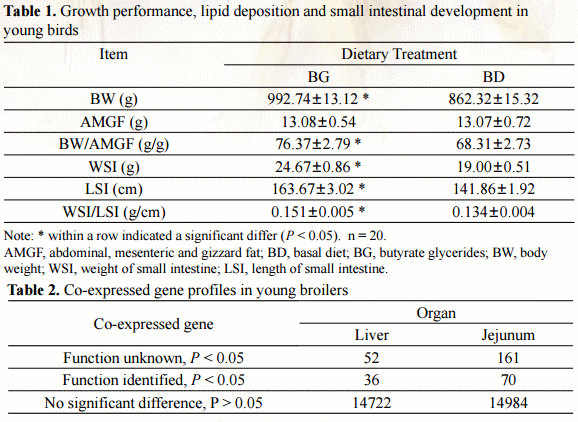Potential of Butyrate Glycerides as an Alternative to Dietary Antibiotics: A Mechanistic Study with Broilers
Published: August 8, 2016
By: Joshua Gong 1; Fugui Yin 1,2; Xiaojian Yang 1; Chengbo Yang 1; Hai Yu 1; Yulong Yin 2; and Steve Leeson 3
/
1 Guelph Food Research Centre, Agriculture and Agri-Food Canada, Guelph, Ontario, Canada;
2 Institute of Subtropical Agriculture, Chinese Academy of Sciences, Changsha, Hunan, China;
3 Department of Animal and Poultry Science, University of Guelph, Guelph, Ontario, Canada
Introduction
Butyrate plays an important role in gastrointestinal health in broilers. Although very efficacious and possible to substitute for dietary antibiotics, pure butyrate has obvious limitations of smell and handling and is virtually absorbed in the upper digestive tract. Butyrate glycerides have no such limitations and their butyrate can be released by lipase in the small intestine, thus providing a novel delivery system to the chicken gut. In our previous pilot experiment, 0.3% butyrate glycerides supplementation in feed improved (P < 0.05) the body weight gain of young birds (up to 20 d) compared to the treatments with non-medicated and virginiamycin-medicated feed. We also observed a reduction of lipids deposition in abdominal and mesenteric fat. Therefore we speculated that the growth promoting and reduction of lipids deposition could be resulted from the energy redistribution. To verify, we have conducted a second chicken trial with a similar design, but reduced numbers of chickens. We have also explored possible mechanisms by examining gene expression profiles in the jejunum and liver of the chickens.
Materials and Methods
Animals and trial design
Fourty newly hatched male chicks were equally divided into two groups: 1) basal diet (BD); 2) basal diet + butyrate glycerides (BG, 0.3% each; 0-7 d: Baby C4 + Mono C4, 7-20 d: Mono C4; SILO, Industria Zootecnica). The protocol for the trial was approved by the Animal Care and Use Committee of the University of Guelph.
Sample collection
All the birds were euthanized at 9:30 am after weighted on d 21. The whole small intestine, from proximal duodenum to the distal ileum, was collected and then the length was measured. The abdominal and mesenteric fat and the fat on the gizzard were isolated and weighted. After removal of digesta, the small intestine was washed three times with pre-cooled PBS and then paper towel dried prior to weighting. About 0.5 g liver and 1 cm jejunum collected from the middle part of the jejunum were cut into small pieces and stored in RNA later (Life Technologies Inc., Burlington, Canada) for gene expression analysis.
RNA extraction and transcriptome sequencing
Two birds from each of the BD and BG treatment groups were randomly selected for RNA extraction and transcriptome analysis. The RNA was extracted from the liver and jejunum of individual birds and then treated with DNase I using Ambion mirVana miRNA isolation kit. The mRNA-Seq libraries were constructed from 10 µg of total RNA of each tissue sample using the Illumina mRNA-Seq sample preparation kit. The liver and jejunum library samples (2 from each treatment) were individually sequenced using the Illumina Genome Analyze II system (Next Generation Sequencing Platforms Clinical Genomics Centre, Mount Sinai Hospital, Toronto, Canada).
Determining possible signaling and metabolic pathways
The data on gene expression profiles of liver and jejunum from the transcriptome analysis were subjected to statistical analyses by DESeq. The differentially expressed genes with NCBI gene ID, P value, and folder change were uploaded to the IPA online analysis system (http://www.ingenuity.com/products/pathways_analysis.html) for functional analysis. The genes expressed only in the samples from either BD or BG treated chickens were also uploaded to IPA online analysis system for functional analysis.
Statistical analysis
The data on body weight gain, lipids deposition, and intestinal development were analyzed by the GLM procedure of SAS with T test. A P < 0.05 was used to assess a statistical significance.
Results
Dietary supplementation with BG significantly increased the body weight, small intestine weight and length, the ratio of body weight to abdominal, mesenteric, and gizzard fat weight, and the ratio of small intestine weight to its length by 15.12%, 29.84%, 15.37%, 11.80%, and 12.69%, respectively, when compared with the control group of birds (fed BD only) (Table 1).
There were 32,209 genes available for Gallus gallus, of which 16,406 genes were identified through the trancriptome analysis. In the present study, there were 36 and 70 genes expressed differentially in the liver and jejunum between the two treatments, respectively (Table 2). Additionally, some unique genes (expressed only in either BG or BD-fed chickens, count number > 5) were also observed. Twelve and 4 unique genes were expressed in the liver and jejunum in BG-fed chickens, and 8 and 5 unique genes were expressed in the same organs of the control birds, respectively.
Twenty differentially expressed genes were identified, which were involved in 102 metabolic processes relating to lipid metabolism in the jejunum of BG-fed chickens. Among them, 11, 10, and 9 genes involved in 3 major processes, including regulation of systemic lipid concentration, fatty acid metabolism, and lipid synthesis. Six out of the 20 differentially expressed genes involved in one of the most important lipid metabolism pathway (Figure 1). Ten differentially expressed genes were identified in the liver of BG-fed chickens, which were involved in 29 metabolic processes relating to lipids metabolism. In addition, 12 differentially expressed genes were involved in 5 metabolic processes relating to protein synthesis in the jejunum of BG-fed chickens.


Figure 1. PPARα pathway in lipid metabolism in response to butyrin treatment in young chickens. While 4 genes with the role in fatty acid transport are downregulated (in green), 2 genes in fatty acid oxidation are up-regulated (in red).
Conclusion
BG treatment influenced the growth performance, lipid deposition, and small intestine development of young broilers. The effects on the later two were possibly achieved through the regulation of lipid metabolism and protein synthesis. The PPARα pathway is the major one affected by the BG treatment.
Acknowledgement
This research was financially supported by Agriculture & Agri-Food Canada. Fugui Yin is currently a NSERC Visiting Fellow to Canadian Federal Government Laboratories.
Related topics:
Authors:
Poultry Health Research Network
Recommend
Comment
Share
Recommend
Reply
Avitech Nutrition
11 de agosto de 2016
With due respect,
Kindly clearly state the difference between various products available with various strengths. Some are having buffer matrix, some are having esterified and coated with vegetable fat.
There are school of thoughts amongst authors. It seems from writing there is clear inclination or tilt with some particular company's product. As a judge, we need guidance.
Submitted respectfully,
R.v.khaladkat
Recommend
Reply
Venkys
11 de agosto de 2016
Hi
Sodium butyrate is best as compared to calcium solubility is good but also take care of salt after using sodium butyrate u reduced the salt in feed
Recommend
Reply

Would you like to discuss another topic? Create a new post to engage with experts in the community.











.jpg&w=3840&q=75)